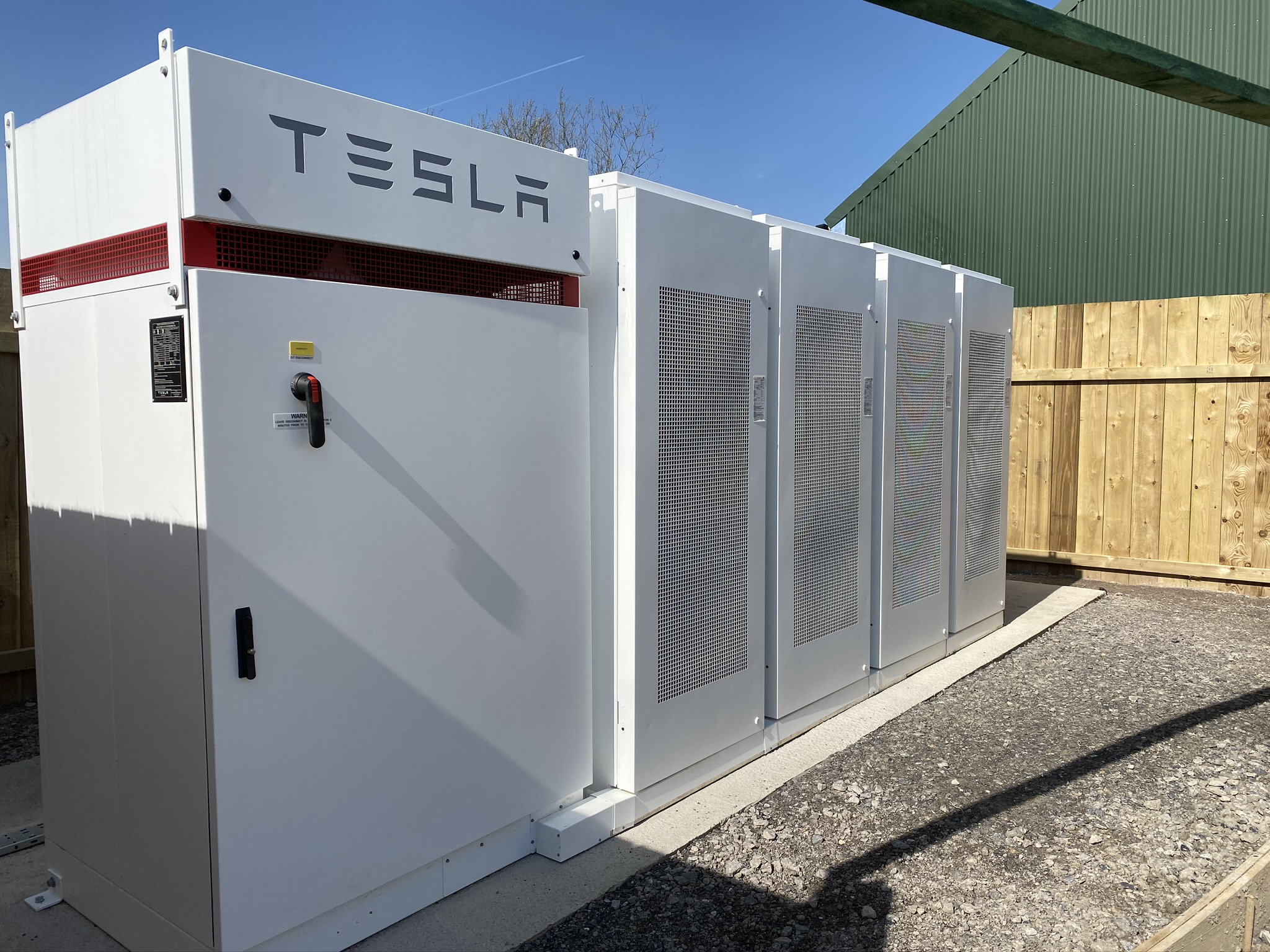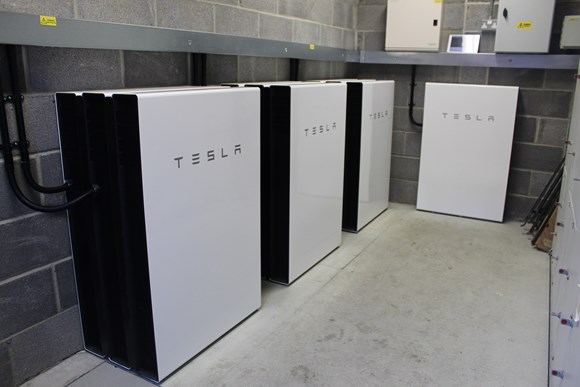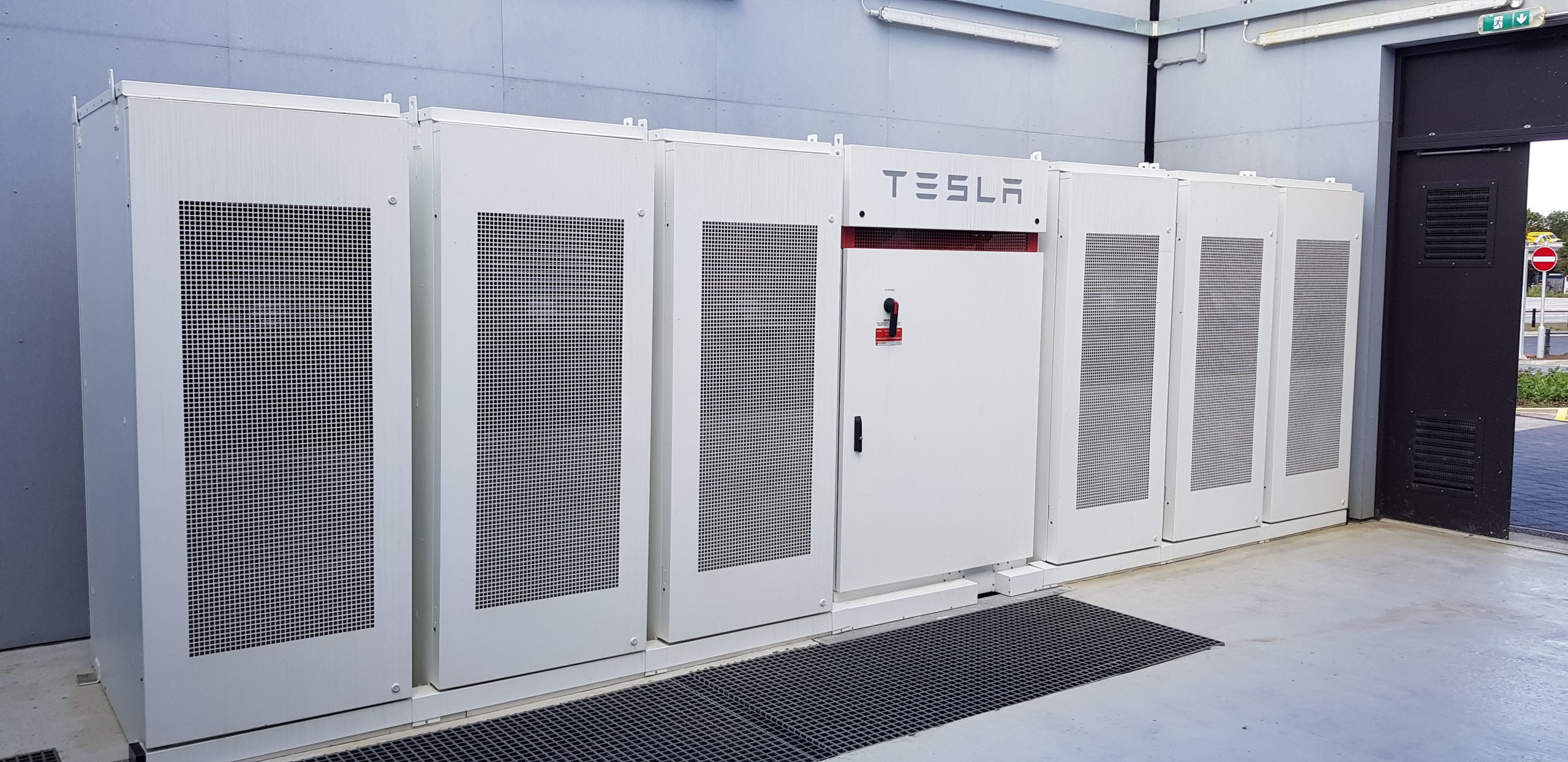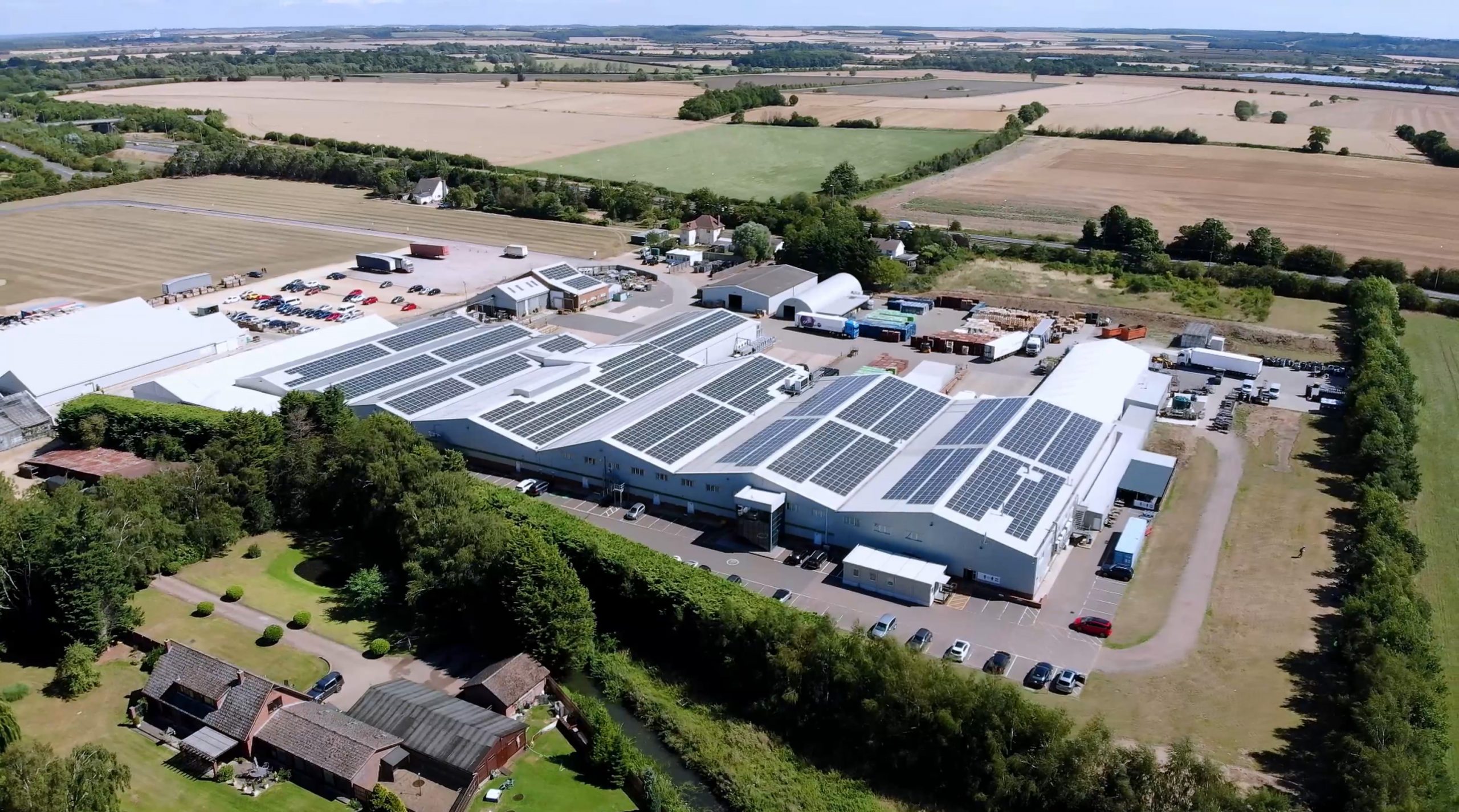How does solar battery storage work?
Solar Batteries are large energy storage units that you would typically position outside a building that charge up during sunny periods when excess solar would be exported, if linked up to a solar PV system, or during the night from the grid if there are low energy prices.
The batteries’ energy management system will monitor charge and discharge the amount of energy stored in the solar battery. The solar batteries themselves are currently often made up of rechargeable lithium-ion, stored in smaller battery packs within the units although battery chemistries are changing over time, as research and development pushes technology advancements in this field.
Combining solar battery storage with solar PV can help revolutionise your organisation’s energy management and carbon savings.
Battery storage can be used to:
- Increase the amount of solar energy used on site
- Generate revenue by offering grid services
- Provide backup energy from the solar panel storage battery
- Capture excess exported energy from wind or solar
- In some cases, batteries for solar power storage can provide an Uninterruptable Power Supply (UPS).

Our recent multi-technology project, HyperHubs provides a perfect example of this. Having a battery and solar PV allows the site to be more flexible as it can pull energy from multiple sources when required. For example, the solar panel storage battery can maximize the solar used on site and also ensures that the electricity used by the EV charging is from a low carbon source. In addition, the site will be able to generate energy during the daytime via the solar PV canopies. Watch below.
How to use captured energy in electric vehicle chargers?
What are the benefits of solar battery storage?
Solar Battery Storage systems can storage the excess energy from your PV system, that would be normally exported to the grid, to be used at a later point when needed on site. This excess energy can be intelligently discharged from the solar battery storage at peak times of day when needed, allowing the organisation to avoid peak energy costs.
Backup power
Solar battery energy storage systems have the ability to provide backup power to your business.
Much like diesel standby generators, they store energy to release during periods of power outage and capture any excess energy generation, which gives you peace of mind that your site will continue to operate in the event of grid power supply disruption.
Uninterrupted Power Supply
Uninterrupted Power Supply (UPS) is a rapid response solar battery storage system: should power fail, then the supply to your business will go on without any interruption.
These batteries for solar power storage systems are there to protect the continuity of your business activities, which is particularly important for companies that depend on power for essential technology or sensitive equipment that could malfunction during a power dropout.
Grid services
A solar panel storage battery can be dedicated to operate at high readiness to support instability in the grid. By doing this, batteries for solar power storage are able to provide support to a power grid. This facility can provide an additional income to your business. Specialist companies called aggregators can offer the interface between National Grid and your battery to access these revenues.
The aggregator, which controls and manages your battery storage system plus many others in synchronicity, on your behalf to earn revenues by providing grid services to the National Grid through competitively bid contracts the aggregator secures.
Load shifting
Your business can reduce energy costs by charging the solar battery storage when energy is cheap: either at night via the grid when tariffs are low and/or during the day with excess solar or wind generation.
The energy can then be ‘shifted’ to periods when energy is expensive (during the day and peak periods.)
Peak shaving
Operating batteries for solar power storage in peak shaving mode will enable you to avoid going over your agreed kVA power capacity.
During these periods, your business can be penalized heavily for using power, therefore, this can make a huge difference in achieving your financial objectives.

Are there any grants available for solar battery storage units?
Not currently although sometimes batteries are included as an allowable technology in low carbon schemes and EV-enabling projects.
Key solar battery storage terms you need to know
Solar battery storage terminology can be overwhelming at times. To help overcome this, we’ve put together a list of key terms to help you understand definitions when researching solar battery storage.
- Energy: Energy is the ability to do work overtime. In the context of a battery, energy refers to the amount of electricity that the battery can store. A unit of energy can be expressed as a Watt-hour (Wh), where 1,000 Wh equals one kiloWatt-hour (kWh) or 1,000 Watts of power delivered consistently over the course of an hour. If you were to imagine a bottle of lemonade, the energy capacity of the battery would be analogous to how much lemonade the bottle could hold.
- Power: Power refers to the amount of electricity that a battery can charge or discharge at any moment. The unit for power is a watt (W), or kilowatt, which represents 1,000 Watts. During research for commercial-sized batteries for solar power storage, you may also encounter megawatt (MW) as a unit, which represents 1,000 kilowatts or 1,000,000 watts. Thinking about the bottle of lemonade again, power would be the maximum rate that the bottle could be filled or drunk.
- kWh: A kWh stands for kilowatt-hour, and is the unit of energy equal to one kilowatt of power used for one hour of time. It is commonly used by electrical appliances or in electricity bills from suppliers, sometimes referred to as a “unit”
- Depth of discharge: The depth of discharge for a solar panel storage battery is the extent to which a battery can be discharged safely, while ensuring enough energy is left to power the battery’s own electric requirements. Overall, depth of discharge is another metric for the amount of energy stored in a solar panel storage battery that is available to you. A standard depth of discharge is between 80 percent and 95 percent.
- Charge cycles: Cycles are a way to gauge the useful life of batteries for solar power storage. The definition of a cycle is not standardized so it is good to check what the definition used by the engineers are, to allow comparison between different batteries. The lifespan of a battery is estimated as the number of cycles that can be completed before performance drops below a designated level.
- Energy throughput: A much clearer and easy-to-measure solar battery usage. Measured by monitoring the energy output of the battery in Wh/kWh/MWh depending on the battery scale.
- C rating; Used to give an idea of the relationship between the power of the solar battery (kW) and the energy capacity of the battery (kWh). Again please be careful here, some manufacturers will give a ratio of kW/kWh and others will describe C rating as kWh/kW. For example, if the battery is 500kW/1000kWh, then the first description will give a C rating of 0.5, and the second a definition of 2 for the same battery.
- Round-trip efficiency: There are electricity losses during the process of converting electricity into stored energy and then back again into usable electricity. Losses are typically low, in the 5 percent range, and round-trip efficiency is a metric that explains the percentage of electricity that can be discharged as a percentage of electricity used to charge the solar panel storage battery.

Where is the best location for a solar battery storage unit?
To ensure your solar battery storage system operates at an optimal level and achieves its expected service life you’ll need to think about where you locate the system, possibly your building insurance company will have an opinion here too as there are some risks and hazards to be mitigated. These are some of the main factors that you need to consider:
- Ventilation and heat: solar battery storage units need to be kept away from sources of heat, such as direct sunlight, and placed a well-ventilated area.
- Accessibility: The battery needs to be placed in a location that is easily accessible for future maintenance
- Safety: The solar battery storage system needs to be enclosed and have an appropriate amount of warning signs to indicate that a large amount of energy is stored inside.
- Protection: Secure the solar panel storage battery enclosure against vermin and extreme weather conditions
- Isolation: In the event of an emergency, you need to be able to quickly isolate your solar battery electricity network or have an automated trip linked to an alarm system.
- Weight: Batteries for solar power storage are heavy objects, therefore a civil engineer will be needed to assess the chosen location and recommend footings as required.
- Inside or outside?: Inside the building is often not the best solution due to potential safety issues and insurance requirements, therefore an outside location is typically more appropriate.

What is the best battery for solar energy storage?
Batteries for solar power storage can be set in different manners to focus on either energy storage or power capacity. The can be made to have different durations of discharge, to benefit your site. For example, a more energy focussed battery would suit a solar energy storage system, to allow longer charging periods over the day and discharge at a low base rate at night. If you are looking for short-term backup power or grid services, then a more power focussed battery would be more appropriate, as a large storage capacity won’t be required.
These preferences are limited by the battery’s chemistry so a 1C Lithium Ion battery 1MW/1MWh operated at maximum power would degrade much more quickly than a 1MW/2MWh lithium Ion battery.
AC vs. DC coupling
There are two types of battery installation systems, known as DC and AC coupling. AC or DC coupling refers to the way solar panels link to a solar battery storage system. They are known as a DC (Direct Current) or AC (Alternating Current) system due to the electrical connection between the solar PV array and battery.
As solar panels generate DC electricity, it can must transform into AC electricity in order to power your home’s appliances. However, solar batteries store electricity in DC form.
AC Coupled System’
In an AC-coupled system, DC electricity flows from your solar panels to a solar inverter. The inverter, transforms the electricity into AC electricity ready to power your home.
However, if this energy isn’t needed, it then goes into another inverter that transforms it back into DC in order to store it into your solar panel storage battery.
When this energy is in demand, it is then inverted again through an AC-to-DC power unit. This is so it is safe to use with the organisation. Ultimately, an AC-coupled system, any electricity stored in a solar battery storage system will need to be inverted a total of three times before use.
DC Coupled System
A DC system connects directly to your Solar Panels before your generation meter. In a DC-coupled system, Direct Current flows from your solar panels to a charge controller that regulates the DC energy to feed into your solar panel storage battery system.
This means that any electricity generated by your solar panels, will be only inverted once from DC to AC, this can be an advantage. However it does limit the relative sizes and powers of PV system to battery available and also the discharge times of the solar battery storage system, e.g. if the solar is generating at the maximum capacity of the inverter, then the battery will not be able to additionally discharge.
Either at the point where the current flows from your battery to your home, or from your battery to the National Grid.
What solar battery storage system size do I need?
The exact solar panel storage battery size you need depends on how you wish to use the battery. In the context of a solar battery storage, this battery size will depend on how much electricity you typically consume during a twenty-four-hour period, when you use electricity, the size of the solar PV system and differences in energy prices at different times of day.
If you already have a PV system, you will hopefully have learned to optimize your usage to focusing on using electricity during daylight hours and minimizing night time use, this would then allow a smaller battery to be installed. If you don’t have a solar PV system and you use a substantial amount of energy per year, you may be metered on a half hourly basis, this data is invaluable to modelling the optimal size of solar battery storage system for your building and is beneficial to have at hand before contacting any energy company.
The exact solar panel storage battery size needed will come down to how much electricity you typically consume during daylight hours and what you wish to achieve with a solar battery. If you are seeking to employ the battery for backup power, then having a typical idea of how much energy you use and how long you wish to have the backup support, e.g. 100KW for 3 hours would require a 300kWh battery. For grid services, solar capacity has little influence and size of connection capacity and the grid’s availability to support the connection are much more important.
At EvoEnergy, we can provide expert calculations to size solar battery storage solutions bespoke to you. Talk to our solar battery storage experts today.

Can I integrate a battery to an existing solar system?
The level of difficulty associated with integrating a battery depends on whether your solar panel system was designed with the intention of adding energy storage later on.
If you have a so-called “storage ready” system, you already have an inverter that can easily integrate a battery into your solar panel setup. In this situation, a battery is relatively simple to install, and the installation process won’t require much additional equipment.
If your solar panel system was not originally designed with the ability to add storage later, the installation could simple be an AC connected battery with its own inverter and connection to the site, or an existing solar inverter could be replaced to a model that accepts solar battery storage.
How can we help your UK business?
As the UK’s market leader in renewable energy solutions, we are in the best position to help your business to offset your carbon emissions. We also offer supplementary technologies, which would work in harmony with an electric vehicle charging facility, such as, site electrical upgrades, battery storage and solar PV, perhaps all combined into a private Smart Grid.
These technologies would allow your business to harness the power of renewable energy and provide enough power needed to fast charge a wide range of electric cars.
Ultimately, it is down to us to make the change towards sustainability in order to create a greener future and create significant energy cost savings. Now is a good time to assess your net zero aspirations and talk to us about how we can help achieve them.
Our team of renewable energy experts are available to provide Net Zero consultancy and renewable (Solar, EV, battery) quotations alongside installation operations and maintenance support to asset owners.
